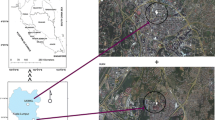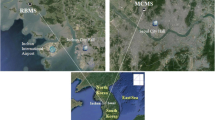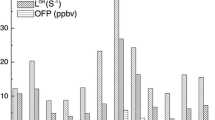Abstract
Air samples were collected in Beijing from June through August 2008, and concentrations of volatile organic compounds (VOCs) in those samples are here discussed. This sampling was performed to increase understanding of the distributions of their compositions, illustrate the overall characteristics of different classes of VOCs, assess the ages of air masses, and apportion sources of VOCs using principal compound analysis/absolute principal component scores (PCA/APCS). During the sampling periods, the relative abundance of the four classes of VOCs as determined by the concentration-based method was different from that determined by the reactivity approach. Alkanes were found to be most abundant (44.3–50.1%) by the concentration-based method, but aromatic compounds were most abundant (38.2–44.5%) by the reactivity approach. Aromatics and alkenes contributed most (73–84%) to the ozone formation potential. Toluene was the most abundant compound (11.8–12.7%) during every sampling period. When the maximum incremental reactivity approach was used, propene, toluene, m,p-xylene, 1-butene, and 1,2,4-trimethylbenzene were the five most abundant compounds during two sampling periods. X/B, T/B, and E/B ratios in this study were lower than those found in other cities, possibly due to the aging of the air mass at this site. Four components were extracted from application of PCA to the data. It was found that the contribution of vehicle exhaust to total VOCs accounted for 53% of VOCs, while emissions due to the solvent use contributed 33% of the total VOCs. Industrial sources contributed 3% and biogenic sources contributed 11%. The results showed that vehicle exhausts (i.e., unburned vehicle emissions + vehicle internal engine combustion) were dominant in VOC emissions during the experimental period. The solvent use made the second most significant contribution to ambient VOCs.
Similar content being viewed by others
References
An, J. L., Zhang, W., & Qu, Y. (2009). Impacts of a strong cold front on concentrations of HONO, HCHO, O3, and NO2 in the heavy traffic urban area of Beijing. Atmospheric Environment, 43, 3454–3459.
Atkinson, R. (1990). Gas-phase tropospheric chemistry of organic compounds: A review. Atmospheric Environment, 24A, 1–42.
Atkinson, R., & Arey, J. (2003). Atmospheric degradation of volatile organic compounds. Chemical Reviews, 103, 4605–4638.
Aunan, K., & Pan, X. C. (2004). Expose–response function for health effect of ambient air pollution application for China—A meta-analysis. Science of the Total Environment, 329, 3–16.
Barletta, B., Meinardi, S., Rowland, F. S., et al. (2005). Volatile organic compounds in 43 Chinese cities. Atmospheric Environment, 39, 5979–5990.
Barletta, B., Meinardi, S., Simpson, I. J., Khwaja, H. A., Blake, D. R., & Rowland, F. S. (2002). Mixing ratios of volatile organic compounds (VOCs) in the atmosphere of Karachi, Pakistan. Atmospheric Environment, 36, 3429–3443.
Borbon, A., Coddeville, P., Locoge, N., & Galloo, J. C., (2004). Characterising source and sinks of rural VOC in eastern France. Chemosphere, 57, 931–942.
Carter, W. P. L. (1994). Development of ozone reactivity scales for volatile organic compounds. Journal of Air Waste Management Association, 44, 881–899.
Chan, C. K., & Yao, X. H. (2008). Air pollution in mega cities in China. Atmospheric Environment, 42, 1–42.
Chen, T. Y., Simpson, I. J., Blake, D. R., et al. (2001). Impact of the leakage of liquefied petroleum gas (LPG) on Santiago air quality. Geophysical Research Letters, 28, 2193–2196.
Duan, J. C., Tan, J. H., Yang, L., et al. (2008). Concentration, source and ozone formation potential of volatile organic compounds (VOCs) during ozone episode in Beijing. Atmospheric Research, 88, 25–35.
Geng, F. H., Zhang, Q., Tie, X. X., et al. (2009). Aircraft measurements of O3, NO x , CO, VOCs, and SO2 in the Yangtze River Delta region. Atmospheric Environment, 43, 584–593.
Geng, F. H., Zhao, C. S., Tang, X., et al. (2007). Analysis of ozone and VOCs measured in Shanghai: A case study. Atmospheric Environment, 41, 989–1001.
Grosjean, E., Rasmussen, R. A., Grosjean, D., et al. (1999). Toxic air contaminants in Porto Alegre, Brazil. Environment Science and Technology, 33, 1970–1978.
Guo, H., Jiang, F., & Cheng, H. R. (2009). Concurrent observations of air pollutants at two sites in the Pearl River Delta and the implication of regional transport. Atmospheric Chemistry and Physics, 9, 7343–7360.
Guo, H., So, K. L., Simpson, I. J., et al. (2007). C1–C8 volatile organic compounds in the atmosphere of Hong Kong: Overview of atmospheric processing and source apportionment. Atmospheric Environment, 41, 1456–1472.
Guo, H., Wang, T., Blake, D. R., et al. (2006). Regional and local contributions to ambient non-methane volatile origanic compounds at a polluted rural/coastal site in Pearl River Delta, China. Atmospheric Environment, 40, 2345–2359.
Guo, H., Wang, T., & Louie, P. K. K. (2004). Source apportionment of ambient non-methane hydrocarbons in Hong Kong: Application of a principal component analysis/absolute principal component scores (PCA/APCS) receptor model. Environmental Pollution, 129, 489–498.
Ho, K. F., Lee, S. C., Ho, W. K., et al. (2009). Vehicular emission of volatile organic compounds (VOCs) from a tunnel study in Hong Kong. Atmospheric Chemistry and Physics Discussion, 9, 12645–12674.
Hsieh, C.-C., & Tsai, J.-H. (2003). VOC concentration characteristics in Southern Taiwan. Chemosphere, 50, 545–556.
Kansal, A. (2009). Sources and reactivity of NMHCs and VOCs in the atmosphere: A review. Journal of Hazardous Material, 166, 17–26.
Katsoyiannis, A., Leva, P., & Kotzias, D. (2008). VOC and carbonyl emissions from carpets: A comparative study using four types of environmental chambers. Journal of Hazardous Materials, 152, 669–676.
Leuchner, M., & Rappenglück, B. (2009). VOC source–receptor relationships in Houston during TexAQS-II. Atmospheric Environment. doi:10.1016/j.atmosenv. 2009.02.029.
Liu, Y., Shao, M., Lu, S. H., et al. (2008). Volatile Organic Compound (VOC) measurements in the Pearl River Delta (PRD) region, China. Atmospheric Chemistry and Physics, 8, 1531–1545.
Liu, Y., Shao, M., Zhang, J., et al. (2005). Distribution and source apportionment of ambient volatile organic compounds (VOCs) in Beijing city, China. Journal of Environmental Science and Health, 40, 1843–1860.
Monod, A., Sive, B. C., Avino, P., et al. (2001). Monoaromatic compounds in ambient air of various cities: A focus on correlations between the xylenes and ethylbenze. Atmospheric Environment, 35, 135–149.
Moschonas, N., & Glavas, S. (1996). C–C hydrocarbons in the atmosphere of Athens, Greece. Atmospheric Environment, 30, 2769–2772.
Na, K., Kim, Y. P., Moon, I., et al. (2004). Chemical compounds of major VOC emission sources in the Seoul atmosphere. Chemosphere, 55, 585–594.
Pang, X. B., & Mu, Y. J. (2006). Seasonal and diurnal variations of carbonyl compounds in Beijing ambient air. Atmospheric Environment, 40, 6313–6320.
Primn, R., Cunnold, D., Rasmussen R., et al. (1987). Atmospheric trends in methylchloroform and the global average for the hydroxyl radical. Science, 238, 945–950.
Ran, L., Zhao, C. S., Geng, F. H., et al. (2009). Ozone photochemical production in urban Shanghai, China: Analysis based on ground level observations. Journal of Geophysical Research, 114, D15301. doi:10.1029/2008JD010752.
Ras, M. R., Marce, R. M., & Borrull, F. (2009). Characterization of ozone precursor volatile organic compounds in urban atmospheres and around the petrochemical industry in the Tarragona region. Science of the Total Environment, 407, 4312–4319.
Tie, X. X., Geng, F. H., Peng, L., et al. (2009). Measurement and modeling of O3 variability in Shanghai, China: Application of the WRF-Chem model. Atmospheric Environment, 43, 4289–4302.
Wang, T., Ding, A. J., Gao, J., et al. (2006). Strong ozone production in urban plumes from Beijing, China. Geophysical Research Letters, 33, L21806. doi:10.1029/2006GRL027689.
Wang, J. L., Wang, C. H., Lai, C. H., et al. (2008). Characterization of ozone precursors in the Pearl River Delta by time series observation of non-methane hydrocarbons. Atmospheric Environment, 42, 6233–6246.
Wang, T., Wei, X. L., Ding, A. J., et al. (2009). Increasing surface ozone concentrations in the background atmosphere of southern China, 1994–2007. Atmospheric Chemistry and Physics Discussion, 9, 10429–10455.
Xie, X., Shao, M., Liu, Y., et al. (2008). Estimate of initial isoprene contribution to ozone formation potential in Beijing, China. Atmospheric Environment, 42, 6000–6010.
Yao, X. H., Lau, A. P., Fang, M., Chan, C. K., & Hu, M. (2003). Size distributions and formation of ionic species in atmospheric particulate pollutants in Beijing, China: Inorganic ions. Atmospheric Environment, 37, 2991–3000.
Zhang, J., Wang, T., Chameides, W. L., et al. (2007). Ozone production and hydrocarbon reactivity in Hong Kong, Southern China. Atmospheric Chemistry and Physics, 7, 557–573.
Zhang, Y. H., Su, H., Zhong, L. J., et al. (2008). Regional ozone pollution and observation-based approach for analyzing ozone–precursor relationship during the PRIDE-PRD2004 campaign. Atmospheric Environment, 42, 6203–6218.
Author information
Authors and Affiliations
Corresponding author
Rights and permissions
About this article
Cite this article
Jun-lin, A., Yue-si, W., Fang-kun, W. et al. Characterizations of volatile organic compounds during high ozone episodes in Beijing, China. Environ Monit Assess 184, 1879–1889 (2012). https://doi.org/10.1007/s10661-011-2086-7
Received:
Accepted:
Published:
Issue Date:
DOI: https://doi.org/10.1007/s10661-011-2086-7




